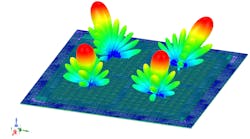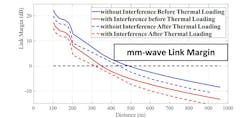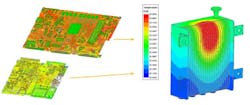The 7 Pillars of 5G/6G RF System Design (Part 2): RF Power
This article is part of the TechXchange: Software & Design Tools.
Members can download this article in PDF format.
What you’ll learn:
- How power consumption affects service providers multidimensionally.
- The intricate relationship between power, performance, and design choices.
- What designers are doing to make full-performance 5G systems more manageable and less costly for service providers to deploy and operate.
As discussed in Part 1 of this series, customer service providers (CSPs) manage telecommunication systems as a business that yields profitable activity. The determining factor upon which they focus is the total cost of ownership (TCO). TCO is a numerical value driven by direct and indirect components.
The direct elements include:
- Number of base stations to serve a given region. Does the carrier choose fewer base stations with more power, or more base stations with lower power to cover a service area?
- The electric bill. What are the power costs to a base-station operator, and how can they be managed? What power profiles are expected at peak traffic and low traffic periods?
- Reliability. How long will the equipment operate before maintenance schedules dictate replacement of modules or subsystems? How do we minimize costly “truck rolls” for on-site repair, adjustments, or service? How is reliability influenced by power consumption?
- Equipment and technology. What does the equipment cost? Does the carrier use cutting-edge or more conventional technology? Does the local base station have edge processing capabilities, requiring more hardware and support systems (cooling, power conditioning, monitoring, diagnostics, etc.?)
- Installation. Municipality permits and licenses for tower or antenna head installations aren’t cheap. Some locations may be more costly than others. Tower structures may need to be erected in some cases, where in other cases buildings or other existing infrastructure could be used to elevate antenna systems.
Indirect factors consist of:
- Customer satisfaction. This is related to network performance (including key performance metrics such as call drop rate, sustained data rate, or effective coverage area). When network performance degrades or otherwise proves unsatisfactory, customers vote with their wallets and jump to different carriers.
- “Second Order” costs. These stem from training, software updates, management, documentation, insurance, and other ongoing support and administrative functions.
The Power Bill is the Elephant in the Room
Paying the local electrical utility is the major driver for TCO and the number one sustainability issue for 5G base stations. Energy consumption accounts for about half of all telco network operations costs. Electric power demands for 5G base stations are expected to be dramatically higher than previous-generation 4G systems.
5G base stations consume much more energy than 4G base stations: MTN Consulting, from April 2020, notes that the typical 5G site requires over 11.5 kW, which is nearly 70% higher than a previous-generation base station supporting a mix of 2G, 3G, and 4G radios (Fig. 1).
This increases the demand on the local power grid, as well as on the requirements for backup power systems that must keep base stations running in the event of a supply power outage. Consequently, sustainability is pushed unfavorably away from realizable self-power options intended to support environmental initiatives (i.e., local solar, wind, or water power.)
Losses are higher when it comes to the simple delivery of power to these base stations, requiring that the distance from supply to base station be limited where possible. Finally, power draw is further exacerbated by the deployment of co-located edge computing resources to support local IoT deployments and low-latency network applications—things that weren’t available in 4G networks.
What, then, are the major drivers for electric power costs for a base station, and how can they be optimized to reach the best TCO?
From this Nokia treatise, we can see that a typical base station consumes power in the following manner:
- 10% of power is lost in the transmission from power plant to base station. (This is a cost factor in the sustainability equation.)
- 80% of the resulting power in the base station is spent in the radio access system. The rest is spent in transport, core and operational support systems (OSS.)
- An estimated 30% of the power delivered to the BTS is actually used in direct revenue-generation; the rest is used in auxiliary passive components like air and power conditioning, fans, and power supplies.
Base-station technology developers are responding to these electrical cost challenges by turning to a number of solutions to conserve power, reduce the TCO, and deliver more sustainable solutions with reduced carbon footprints:
AI-based solutions for managing energy use in peak and off-peak periods
During off-peak demand periods, unused active and passive systems can be put into a standby “sleep mode” or even powered down entirely. Optimization of area coverage is also being optimized through the use of AI/ML-based azimuth and elevation angle adjustment for beamsteering. In addition, ML algorithms are being employed to monitor power draw and identify anomalies, failures or leakages.
Trading antenna size for transmitter power
An engineering method that’s been adopted directly ties the RF link budget to the effective isotropic radiated power (EIRP). The EIRP is a product of the total transmitted power and the effective size of the antenna system as determined by its radiation pattern directive gain. The larger the antenna system, the greater its directive gain. Larger arrays can achieve the same EIRP as a smaller array by using less power per radiating element.
Larger arrays enable lower-power transmit chains to achieve the same EIRP if RF transmitter amplification is performed at the element (or sub-array) level. This makes transmit functions less complex, cooler (heat generation is spread out across more elements), and less costly to design and maintain (though in the end you will need more of them). Another potential benefit with larger arrays is they make more multiple-input, multiple-output (MIMO) channels available, which is a consideration in the total service capability as well.
Naturally, deploying larger arrays has its downsides. In addition to increasing size, weight, and thermal challenges, they require more transmit channels or more analog signal beamforming, with an impact on potential RF power loss.
Trading transmitter and receiver amplification processes
Another emerging system engineering approach involves larger arrays with lower power per channel, which in turn enables lower-cost semiconductor alternatives. More specifically, lower power consumption makes it possible to use silicon-based processes, such as silicon germanium (SiGe) or CMOS. Higher transistor power usually requires the inclusion of costly III-V compound semiconductors like gallium arsenide (GaAs), gallium nitride (GaN), or even more exotic combinations.
Down at the VLSI design level, transistor chains require high linearity to avoid channel crosstalk from modulation impurities generated in the amplification processes. Power efficiencies in these amplifiers range from 30% to 45%, which represents power loss and thermal generation. The higher the power in the channel, the more acute the challenges.
Low-noise amplifiers (LNAs) at the receiver front-end require matching for optimal noise. LNAs can consume appreciable power in the overall system power budget. This is critical for maximizing the receiver’s sensitivity. But optimal noise match often comes at the expense of power efficiency. Trading power efficiency for noise match is seen as a necessary performance-driven tradeoff to make.
Another component that drives power consumption at the VLSI level is the high-speed sampler in the analog-to-digital (A/D) components used in the receiver baseband stage, and the digital-to-analog (D/A) parts in the transmitter exciter and modulator. In general, the higher the sampling speed and the greater the number of bits used in the A/D and D/A components, the more power they consume.
The trend toward gaining spatial diversity through MIMO methods is clearly on the rise. However, more MIMO channels require more receiver channels, which leads to the need for more LNAs in the system design. Similar to transmitter power amplifiers, tradeoffs at the semiconductor level must be scrutinized to optimize the implementation. Tradeoffs also extend to power requirements versus thermal considerations— a conundrum that can be aggravated by the fact that best noise match is often achieved at high bias current points.
How Computational Multiphysics Simulation Can Help
From the above discussion, it can be safely concluded that optimizing power draw and costs for a base-station implementation is a complex multiphysics optimization. To fully understand the cost of both radio head and auxiliary systems, it becomes necessary to develop and size thermal mitigation approaches at the chip, package, and board level, experiment with the size of fans, compare against the impact on air-conditioning requirements, and more.
Heat causes mechanical and structural challenges in boards, chips, antennae, and chassis through material expansion and warping. Power consumption itself is an electromagnetic phenomenon (Fig. 2). These directly interdependent and interactive factors are driven by communication-system data loading (traffic) and RF drive levels. They all affect component and system reliability, which translates into operational, maintenance, repair, and replacement costs.
TCO is thus ultimately a computational multiphysics problem. Tools for capturing the electromagnetic fields associated with an antenna and its supporting electronics, as well as the thermal effects their operations generate, are needed to ensure signal, thermal, and power integrity at both the component and system level. The structural impact of heat requires another simulator that models and simulates mechanical effects.
Converging on a solution for such a dynamic, multivariant problem can be something of a Gordian Knot for mere mortals. It calls for an appropriate optimization platform that takes advantage of the nonlinear capabilities of ML algorithms to accelerate its resolution. Workflows/methodologies and robust interfaces between all of these tools allow not only the proper data interactions and file sharing, but also facilitate scaling the problem from micro to macro while preserving accuracy in modeling and simulation results.
Finally, a tool for model-based system engineering (MBSE) ties it all together. It helps a design team drive the computational, multiphysics-based, virtual-prototyping effort from the perspective of meeting specifications and KPIs while experimenting freely to develop a holistically optimized end product that maximizes operational profit for the customer service provider.
But it must not be forgotten that power is simply one of the seven pillars that must be completed for 5G system design. The next installment in this series will examine the second pillar: antenna sizing.
Read more articles in the TechXchange: Software & Design Tools.


